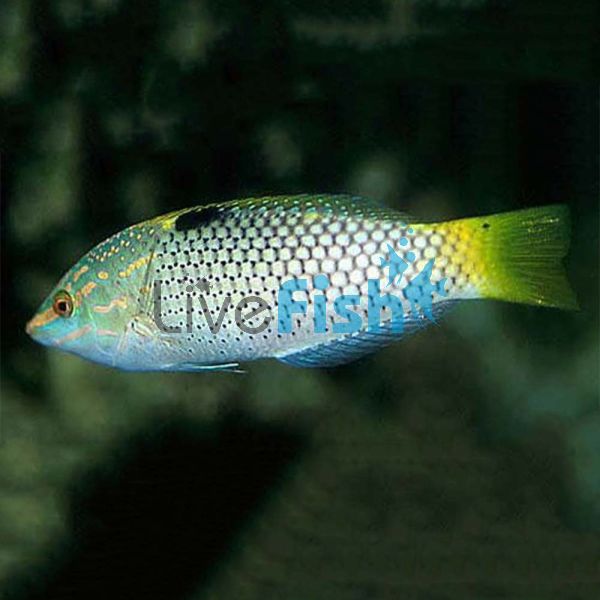Checkerboard Wrasse - Small
The Checkerboard Wrasse is a fascinating species that will change from its striped juvenile colouring into its impressive chessboard-like marked glory as it ages.
Checkerboard Wrasse
Juvenile Checkerboard Wrasse will start out their lives a silvery-white colour with 3 vertical black patches spread out along its body from the head to tail. A distinctive black spot outlined in yellow can also be seen on its back. As it matures the body will lighten and become more white with a green face and various orange and pink markings around it. It will also develop a black spot between each of its scales which gives it the checkerboard appearance and name along with a bright yellow tail fin.
Each fish is born as a female and depending on social cues will transform into a male when needed. In the wild, there would normally be several females and only one male present within a certain area. If the male disappears for whatever reason then the most dominant female would take on the role and change into a male.
These powerful swimmers are always on the move and will cruise around your tank constantly on the lookout for food and only stopping to take a bite. They have been observed bashing small fish against rocks to break them into pieces before consuming them.
They can be found all over the tropical areas of the Indo - Pacific region from South East Asia over to the Red Sea and Australia. The juveniles will hang around under ledges for protection close to nearby sandy holes. Adults are usually seen inhabiting reefs and lagoons down to 30 metres.
Tank Recommendations for Juvenile Checkerboard Wrasse
The smallest tank size for this species is 380 litres. Make sure the tank has plenty of horizontal space, as during daylight hours these fish will be constantly swimming around. They also need lots of crevices and caves. Take care not to obstruct the swimming areas. Be sure to provide a fine sand bed (no bigger than 2mm) of about 10 cm deep as checkerboard wrasse will bury themselves in the sand when juveniles. Sand particles can be dispersed into the water column and settle on top of coral by the wrasse's constant hunting and diving into the sand bed looking for food. For this reason, they should always be kept in a fish only tank.
Suitable Tank Buddies
This species of wrasse is best kept with more active, larger and aggressive tank buddies. Slower more docile fish can be bullied and may not be able to eat. A pair can be kept, but be aware that two males will fight each other for dominance.
Usually Compatible
Boxfish and large Angelfish would be great choices to combine with this species. Other wonderful options such as Damsels, Fancy Damsels and Tangs would make good tank buddies as well.
Sometime Compatible
Keep an eye on Pufferfish, Groupers, Parrotfish and Clownfish if housed with the Checkerboard Wrasse. Eels, Dwarf Angelfish, Butterflyfish and Cardinalfish should also be observed carefully as the wrasse may be too quick at stealing food.
Rarely Compatible
Slower moving species such as Pipefish and Seahorses may starve in the presence of this fish. Batfish won't be able to compete either. Sharks should be avoided as they will see the wrasse as prey. Any decorative invertebrates and crustaceans will be hunted down too.
Feeding Your Juvenile Checkerboard Wrasse
This species is carnivorous and thrive in the wild on a diet of sand-dwelling creatures such as gastropods, crabs and even small fish. In your aquarium, you will need to offer them a diet that consists of high-quality marine pellet and flake food. You should also include frozen mysis and/or brine shrimp. Ensure foods are vitamin enriched if possible as this will help maintain their immune system as well as prevent colouring from fading.
| Scientific Name | Halichoeres hortulanus |
|---|---|
| Care Level | Moderate |
| Common Names | The Checkerboard Wrasse is also known as the Marble Wrasse and the Hortulanus Wrasse |
| Diet | Carnivore |
| Fish Family | Labridae |
| Lifespan (years) | 6 |
| Max. Length (cm) | 28 |
| Min. Tank Volume (l) | 380 |
| Origin | Indo-Pacific |
| Reef Safe | No |
| Sociability | Peaceful |
| Venomous | No |
| Water Conditions | 22.2-25.5° C (72-78° F), dKH 8-12, pH 8.1-8.4, sg 1.020-1.025 |




